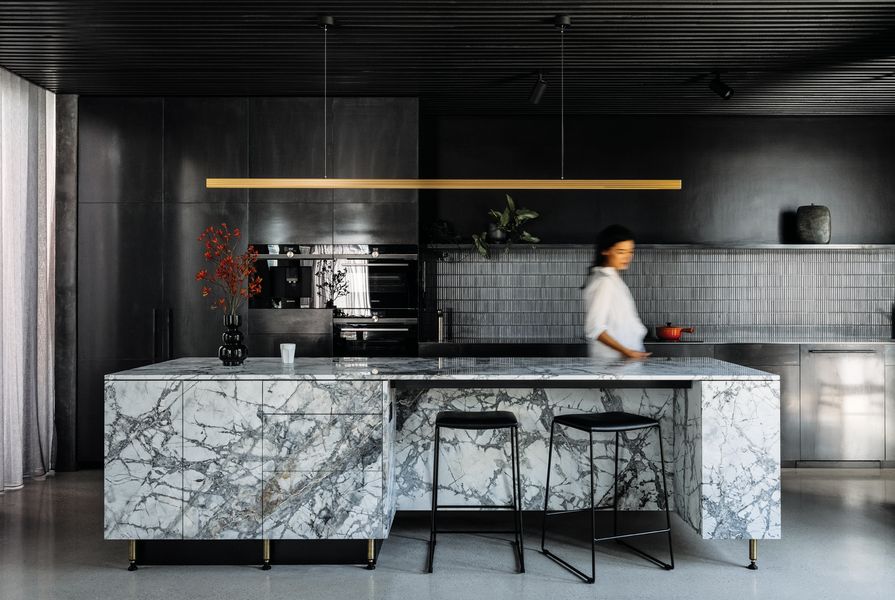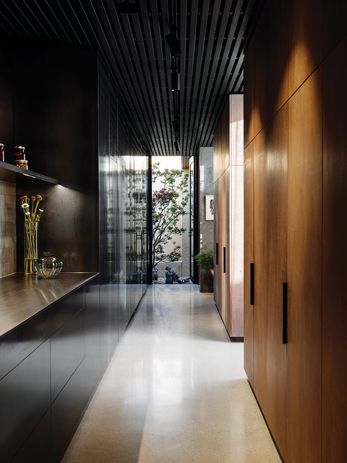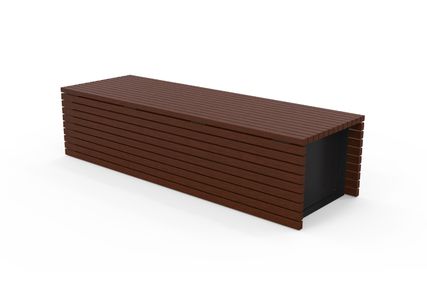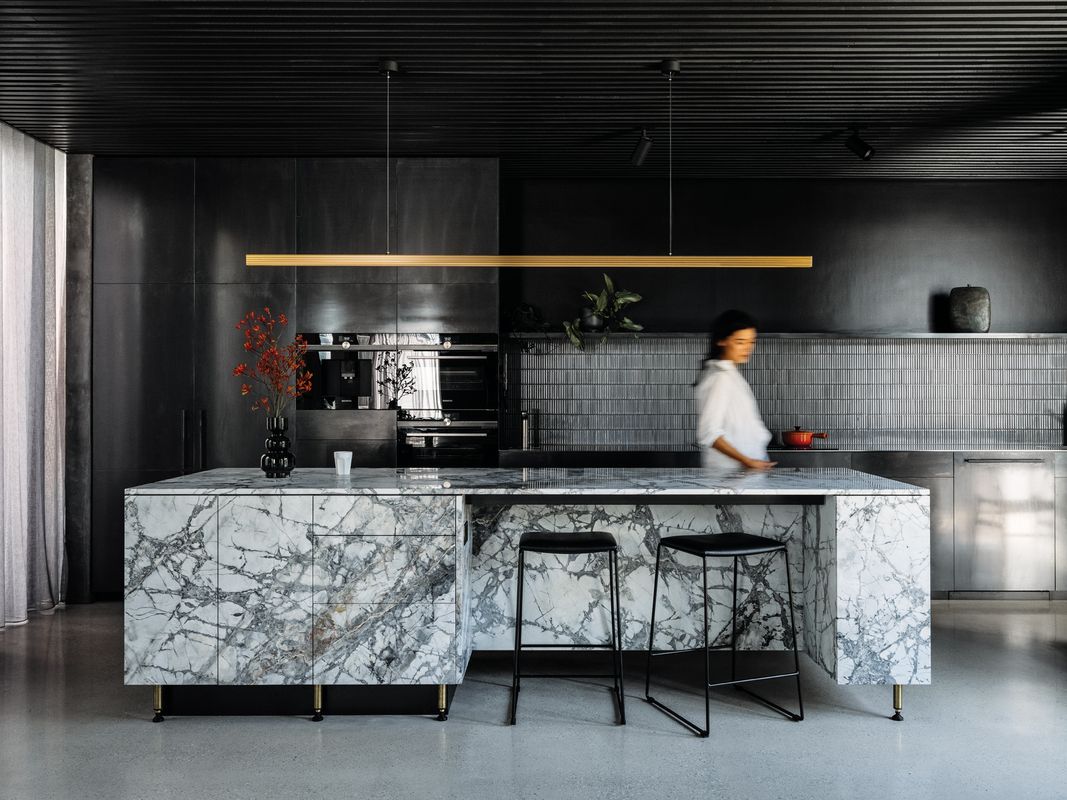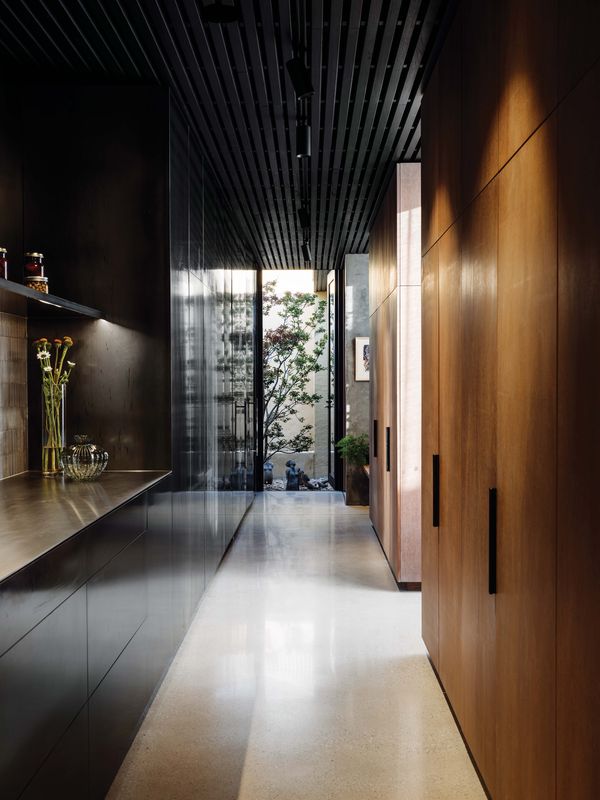Archier has created a sense of depth at this single-storey house in Hobart by weaving courtyards through the floor plan and using materials that reflect light, colour and movement. “Expanding the sense of volume in the house using both landscape and reflection was the driver of design, so the house discreetly mirrors what is in and around it,” says Chris Haddad, co-director of Archier.
Located in Battery Point, Hobart, the two-bedroom cottage was originally the local milk depot, and it was subject to stringent heritage overlays. The clients engaged Archier to design a single-storey house where they could age in place. They wanted space to entertain, display their art collection and accommodate their children and grandchildren when they came to stay.
As with the rest of the house, materials in the utility spaces were chosen to reflect the colours and textures of the local environment.
Image: Adam Gibson
The architects designed a rear addition that merges house and garden, with the floor plan spreading out across the site and wrapping around landscaped courtyards that bring light, ventilation and views into the home. A glazed walkway connects the refurbished cottage and new extension, passing between two courtyards and showcasing the cottage’s original facade.
The warm and traditional palette in the front cottage is sympathetic to the building’s heritage, while the raw and elemental materials of the addition are a bold contrast. Dark, robust and masculine, the kitchen, dining and living area has a meditative atmosphere and is a gallery-like space for the clients’ display of art. The polished concrete floor, dark-stained Tasmanian oak ceiling and grey-rendered walls offer a monochromatic backdrop that allows the striking granite island bench to come to the fore. The granite clads all sides of the bench, with its dramatic and graphic veining accentuated against the mild-steel cabinetry, stainless benchtop and silver-blue splashback tiles.
“Even though it’s a dark palette, the materials have a beautiful reflective quality, so you catch glimpses of colour and movement, which amplifies the natural light coming into the home through the extensive courtyard glazing,” says Chris. This reflective quality is amplified in the courtyard, which Chris describes as having a “mirror-box effect.” Here, the continuous glazing reflects the house and garden, as well as the chimneys and rooftops of neighbouring houses, helping to embed the addition in its historic site.
The ensuite’s bathtub is positioned to capture a view of kunanyi, reflected in the mirror.
Image: Adam Gibson
The granite is also a feature in the ensuite, cladding the vanity, which stands out dramatically against the glossy black wall tiles. These glisten with light from the courtyard, while the bathtub is positioned to take in a view of kunanyi/Mount Wellington, reflected in the mirror.
Products and materials
- Kitchen walls and ceiling
- Custom profiled Tasmanian oak battens in Porter’s Paints ‘Japan Black’ oil finish; Rockcote Cerano trowel-finished render with grey tint
- Kitchen flooring
- Hazell Bros concrete screed with 10-millimetre Summers aggregate mix
- Kitchen joinery
- Custom mild steel joinery fronts, shelving and hand-forged door pulls with polished wax finish by Wellington Steelworks; Custom Cabinets stainless steel benchtop with integrated sinks and plywood joinery fronts in Livos Australia Kunos Natural Oil Sealer; Artedomus Concordia stone island bench, cut and installed by Heritage Stone, with Lithofin MN Stain-Stop sealer; Inax Yohen Border tiles from Artedomus
- Kitchen lighting
- Archier Capital 2400-millimetre fluted brass pendant with wax finish; Unios Kobe track lights
- Kitchen sinks and tapware
- KWC stainless steel pull-out kitchen mixer; Billi boiling and chilled filtered water dispenser
- Kitchen appliances
- Liebherr integrated fridge and freezer; Siemens coffee machine, dishwasher, steam oven, pyrolitic oven and induction cooktop with integrated ventilation system
- Kitchen doors and windows
- Custom Cabinets Tasmanian oak double-glazed french doors and windows
- Other kitchen products
- Rio bar stools from Featherston Interiors; Craig Howard and Son custom dining table; Decorama Hobart curtains
- Bathroom walls and ceiling
- Custom profiled Tasmanian oak battens in Porter’s Paints ‘Japan Black’ oil finish; Asimina Spanish Plaqueta tiles in ‘Lord Navy’ with crackle finish
- Bathroom flooring
- Hazell Bros concrete screed with 10-millimetre Summers aggregate mix
- Bathroom joinery
- Artedomus Concordia stone vanity, cut and installed by Heritage Stone, with Lithofin MN Stain-Stop sealer
- Bathroom lighting
- Unios Kobe track lights
- Bathroom tapware and fittings
- Faucet Strommen Pegasi tapware in ‘Raw Brushed Brass’
- Sanitaryware
- Victoria and Albert Edge countertop basin and Mozanno freestanding bath
- Doors and windows
- Custom Cabinets Tasmanian oak full-height windows in Porter’s Paints ‘Japan Black’ oil finish Other:
- Other bathroom products
- Verde Round Recycled Elm Low Stool; Decorama Hobart curtains
Credits
- Project
- Veil House
- Architect
- Archier
Melbourne, Vic, Australia
- Project Team
- Chris Gilbert, Josh FitzGerald, Chris Haddad, Jon Kaitler, Ryan Tubby, Oskar Kazmanli-Liffen, Will Harkness
- Consultants
-
Builder
Jackman Builders
Building surveyor Pitt and Sherry Building Consultants
ESD consultant Red Sustainability Consultants
Interior design consultant Hearth Studio
Landscape design Landart
Structural and hydronic consultant Gandy and Roberts Consulting Engineers
- Site Details
-
Location
Battery Point,
Hobart,
Tas,
Australia
- Project Details
-
Status
Built
Completion date 2019
Category Residential
Type Alts and adds
Source
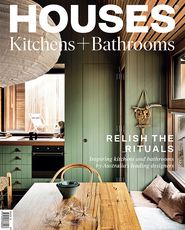
Project
Published online: 4 Jun 2021
Words:
Rebecca Gross
Images:
Adam Gibson
Issue
Houses: Kitchens + Bathrooms, June 2020

